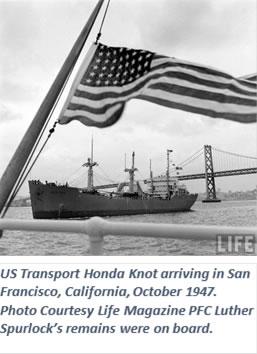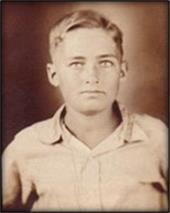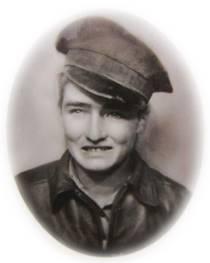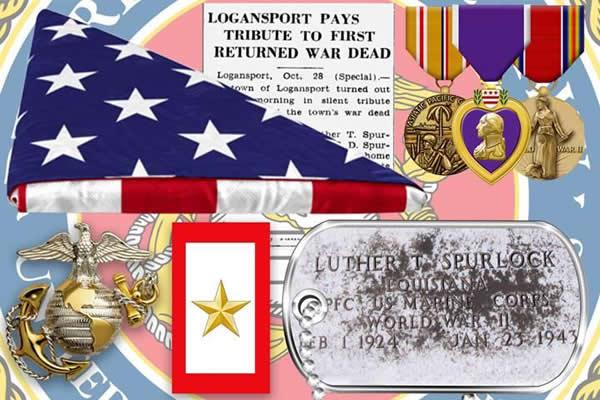 Private First Class Luther T. Spurlock
Private First Class Luther T. Spurlock
United States Marine Corps, World War II
2nd Marine Brigade - Killed in Action – American Samoa
 November 20, 2017 - The late morning of October 10th, 1947 was described as overcast skies as 5,000 mourning people showed up on San Francisco’s Marina Green awaiting the arrival of the United States Transport Honda Knot that was bringing home the remains of 3,012 fallen Americans from the Pacific theater. Ironically many of them had passed under the Golden Gate Bridge a few years before bound for war. At 11:37 am the Honda Knot slipped under the Golden Gate and into San Francisco Bay and were met by an escort of 48 fighter planes that flew over dipping their wings in salute and were then gone. This day officially began what one observer called “the most melancholy immigration movement in the history of man.”
November 20, 2017 - The late morning of October 10th, 1947 was described as overcast skies as 5,000 mourning people showed up on San Francisco’s Marina Green awaiting the arrival of the United States Transport Honda Knot that was bringing home the remains of 3,012 fallen Americans from the Pacific theater. Ironically many of them had passed under the Golden Gate Bridge a few years before bound for war. At 11:37 am the Honda Knot slipped under the Golden Gate and into San Francisco Bay and were met by an escort of 48 fighter planes that flew over dipping their wings in salute and were then gone. This day officially began what one observer called “the most melancholy immigration movement in the history of man.”
A 21-gun salute marked the beginning of the memorial service and a navy launch approached the Honda Knot and presented a seven-foot wreath from President Truman containing leaves of trees from all corners of the country. A one minute moment of silence was observed with the signal from church bells throughout the city. At the end of the 30 minute ceremony the Transport Honda Knot continued to the Oakland Army base where six caskets representing each branch of service and service civilians were selected to lie in state in the rotunda of San Francisco’s City Hall. It was reported that thousands of mourners filed by the coffins or knelt in prayer. By the end of three days all caskets were on their way to their final resting places in accordance with the wishes of their next of kin.
 These were the same two opening paragraphs of the biography I wrote for 2nd Lt. Marvin Crausby of Timpson in February 2016. The remains of Joaquin, Texas native, US Marine Corps Private First Class Luther T. Spurlock was also a part of the over 3,000 fallen Americans that arrived that October day aboard the Honda Knot.
These were the same two opening paragraphs of the biography I wrote for 2nd Lt. Marvin Crausby of Timpson in February 2016. The remains of Joaquin, Texas native, US Marine Corps Private First Class Luther T. Spurlock was also a part of the over 3,000 fallen Americans that arrived that October day aboard the Honda Knot.
Luther was born in Joaquin on February 1, 1924 to Columbus, Sr. and Mary Jane Victoria Eason-Spurlock. His father registered for the World War I draft in 1917 but was never called to serve and younger brother Columbus, Jr. served in the Army Reserve from 1946-1949. He also had one other brother and four sisters.
 Growing up the family lived in various places that included Shelby County, Nacogdoches and Logansport, Louisiana. The month before Pearl Harbor, November 1941, at the age of 17 Luther joined the US Marine Corps. After basic training at Parris Island, South Carolina he joined the 2nd Marine Brigade at Tutuila, the largest and main island of America Samoa. He first showed up on their muster rolls in April 1942 and had attained the rank of Private First Class. His military occupation specialty was truck driver and he was killed in action on January 23, 1943 eleven days before his 19th birthday.
Growing up the family lived in various places that included Shelby County, Nacogdoches and Logansport, Louisiana. The month before Pearl Harbor, November 1941, at the age of 17 Luther joined the US Marine Corps. After basic training at Parris Island, South Carolina he joined the 2nd Marine Brigade at Tutuila, the largest and main island of America Samoa. He first showed up on their muster rolls in April 1942 and had attained the rank of Private First Class. His military occupation specialty was truck driver and he was killed in action on January 23, 1943 eleven days before his 19th birthday.
Fifty-seven months later the remains of PFC Luther M. Spurlock reached the town of Logansport, Louisiana where he parents were now living. The Shreveport Times in their October 29, 1947 edition reported that the town of Logansport turned out in silent tribute as the first of the war dead arrived. His body was taken to the family home eight miles from Logansport and private funeral services were held at 2:30 p.m. at the Willow Grove, Texas Church in Shelby County with the Rev. George Malone officiating. At the time he was survived by his parents Columbus, Sr. and Mary; a sister Mrs. Mavis Gibbs of Logansport; a brother, Columbus Spurlock, Jr. of Logansport; a half-brother Floyd Spurlock of Mansfield; two half-sisters, Mrs. Estelle Arrington of Garrison and Mrs. Evon Danley of Center. He was laid to rest with full military funeral honors at the Willow Grove Cemetery, Joaquin, Texas. Day is done, God is nigh.

Purple Heart, Asiatic Pacific Campaign Medal, World War II Victory Medal
Buried in the Willow Grove Cemetery, Joaquin, Texas
233,181 American dead were returned home after the end of World War II when Congress passed legislation authorizing repatriation of the bodies. Families were given the choice of burial in the United States or overseas in an American military cemetery. 93,242 men were buried overseas in American cemeteries because the families believed it was more appropriate for their loved ones to remain at rest with comrades near the battlefields where they had died. The families of 78,976 dead soldiers had no choice of interment; their sons were listed as missing in action and their remains were never recovered.
The entire repatriation and overseas burial program was conducted from 1945 to 1951, at a cost of $200,000,000 in 1945 dollars (several billion today). It was the most extensive reburial program following a foreign war.
Sources: Life Magazine, page 77-79, 11/3/1947; Memorial Day Foundation.org, 2015; Berkely Publishing Group; Penguin Group (USA) Inc.; Shreveport Times Newspaper 10/11/1947, 10/16/1947, 10/20/1947 and 10/29/1947; Ancestry.com, 2017; FindAGrave.com memorial 54680052, October 2017)









